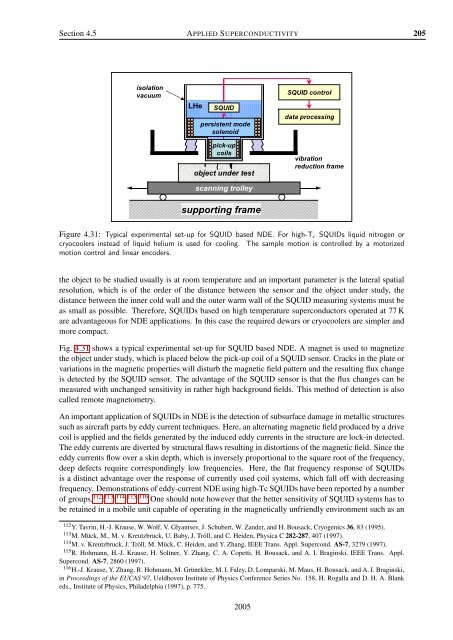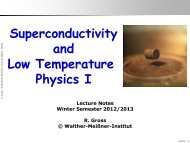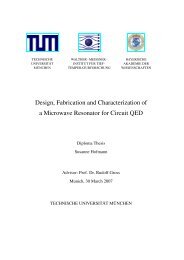Applied Superconductivity - Walther Meißner Institut - Bayerische ...
Applied Superconductivity - Walther Meißner Institut - Bayerische ...
Applied Superconductivity - Walther Meißner Institut - Bayerische ...
- No tags were found...
Create successful ePaper yourself
Turn your PDF publications into a flip-book with our unique Google optimized e-Paper software.
Section 4.5 APPLIED SUPERCONDUCTIVITY 205isolationvacuumLHeSQUIDpersistent modesolenoidpick-upcoilsobject under testscanning trolleySQUID controldata processingvibrationreduction framesupporting frameFigure 4.31: Typical experimental set-up for SQUID based NDE. For high-T c SQUIDs liquid nitrogen orcryocoolers instead of liquid helium is used for cooling. The sample motion is controlled by a motorizedmotion control and linear encoders.the object to be studied usually is at room temperature and an important parameter is the lateral spatialresolution, which is of the order of the distance between the sensor and the object under study, thedistance between the inner cold wall and the outer warm wall of the SQUID measuring systems must beas small as possible. Therefore, SQUIDs based on high temperature superconductors operated at 77 Kare advantageous for NDE applications. In this case the required dewars or cryocoolers are simpler andmore compact.Fig. 4.31 shows a typical experimental set-up for SQUID based NDE. A magnet is used to magnetizethe object under study, which is placed below the pick-up coil of a SQUID sensor. Cracks in the plate orvariations in the magnetic properties will disturb the magnetic field pattern and the resulting flux changeis detected by the SQUID sensor. The advantage of the SQUID sensor is that the flux changes can bemeasured with unchanged sensitivity in rather high background fields. This method of detection is alsocalled remote magnetometry.An important application of SQUIDs in NDE is the detection of subsurface damage in metallic structuressuch as aircraft parts by eddy current techniques. Here, an alternating magnetic field produced by a drivecoil is applied and the fields generated by the induced eddy currents in the structure are lock-in detected.The eddy currents are diverted by structural flaws resulting in distortions of the magnetic field. Since theeddy currents flow over a skin depth, which is inversely proportional to the square root of the frequency,deep defects require correspondingly low frequencies. Here, the flat frequency response of SQUIDsis a distinct advantage over the response of currently used coil systems, which fall off with decreasingfrequency. Demonstrations of eddy-current NDE using high-Tc SQUIDs have been reported by a numberof groups. 112,113,114,115,116 One should note however that the better sensitivity of SQUID systems has tobe retained in a mobile unit capable of operating in the magnetically unfriendly environment such as an112 Y. Tavrin, H.-J. Krause, W. Wolf, V. Glyantsev, J. Schubert, W. Zander, and H. Bousack, Cryogenics 36, 83 (1995).113 M. Mück, M., M. v. Kreutzbruck, U. Baby, J. Tröll, and C. Heiden, Physica C 282-287, 407 (1997).114 M. v. Kreutzbruck, J. Tröll, M. Mück, C. Heiden, and Y. Zhang, IEEE Trans. Appl. Supercond. AS-7, 3279 (1997).115 R. Hohmann, H.-J. Krause, H. Soltner, Y. Zhang, C. A. Copetti, H. Bousack, and A. I. Braginski, IEEE Trans. Appl.Supercond. AS-7, 2860 (1997).116 H.-J. Krause, Y. Zhang, R. Hohmann, M. Grüneklee, M. I. Faley, D. Lomparski, M. Maus, H. Bousack, and A. I. Braginski,in Proceedings of the EUCAS’97, Ueldhoven <strong>Institut</strong>e of Physics Conference Series No. 158, H. Rogalla and D. H. A. Blankeds., <strong>Institut</strong>e of Physics, Philadelphia (1997), p. 775.2005
















